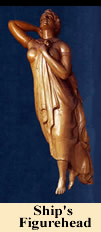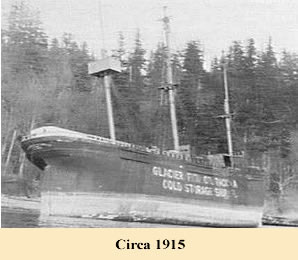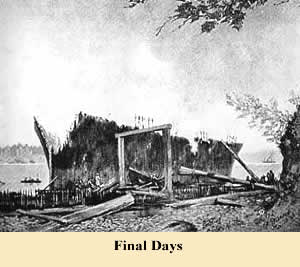 Among
the foremost icons of the 19th century were the clipper ships. They were built to
carry high value cargo over great distances with speed. The most famous designer
of these ships was Donald McKay, a Canadian-born American. Mc Kay designed and built
clipper ships begining in the 1850s. The Glory of the Seas was to be his finest
effort. He bet all his personal assets to build the ship on speculation. The Glory
of the Seas was launched in 1869; on her maiden voyage she made a record run of
94 days from New York to San Francisco. Her arrival there was a great event. She
was admired for the sumptuousness of her craftsmanship. Unfortunately, word of the
instability of McKay's financial condition preceded the vessel, and McKay was compelled
to sell the ship in San Francisco. McKay never financially recovered. She made ocean
voyages until the last years of the 19th century. She was then put into the coast-wise
lumber and coal trade. In the early part of the 20th century she was laid up and
subsequently used as a floating cannery and finally as a storage hulk. She was burned
for her metal south of Brace Point in Seattle in 1923. Among
the foremost icons of the 19th century were the clipper ships. They were built to
carry high value cargo over great distances with speed. The most famous designer
of these ships was Donald McKay, a Canadian-born American. Mc Kay designed and built
clipper ships begining in the 1850s. The Glory of the Seas was to be his finest
effort. He bet all his personal assets to build the ship on speculation. The Glory
of the Seas was launched in 1869; on her maiden voyage she made a record run of
94 days from New York to San Francisco. Her arrival there was a great event. She
was admired for the sumptuousness of her craftsmanship. Unfortunately, word of the
instability of McKay's financial condition preceded the vessel, and McKay was compelled
to sell the ship in San Francisco. McKay never financially recovered. She made ocean
voyages until the last years of the 19th century. She was then put into the coast-wise
lumber and coal trade. In the early part of the 20th century she was laid up and
subsequently used as a floating cannery and finally as a storage hulk. She was burned
for her metal south of Brace Point in Seattle in 1923.
I'm Pat Ford; I've done boat restoration for about 30 years. I also do video production;
I've wanted to find the  remains
of the ship and videotape it. The late esteemed Seattle boatwright, Frank Prothero,
was at the burning of the Glory of the Seas as a boy in the 20s. I had a nodding acquaintance with Frank
as did most of the younger generation of boatwrights around Lake Union. To expiate
his sin of destroying the famous vessel, one supposes, he named his final boat the
schooner Glory of the Seas. remains
of the ship and videotape it. The late esteemed Seattle boatwright, Frank Prothero,
was at the burning of the Glory of the Seas as a boy in the 20s. I had a nodding acquaintance with Frank
as did most of the younger generation of boatwrights around Lake Union. To expiate
his sin of destroying the famous vessel, one supposes, he named his final boat the
schooner Glory of the Seas.
Several years ago I read an article in the local newspaper that discussed the remains
of the ship. At each year's extreme low tides, these vestiges are barely visible.
I took a trip to find that site in 2004, but only found the general location. This
year, with the aid of Michael Jay Mjelde, author of the book Glory of the Seas,
I was able to find the remains.The hull was visible for the last time about forty
years ago. Now the bottom of the hull lies buried beneath a few feet of sand. A
clump of rusting iron fittings are visible; sometimes additional iron fittings boil
up from beneath the sand. I did a brief video of the ship's site; you can view it
below.

I am not interested in the ship because I am a "tallship" enthusiast.
Frankly, these people make me a bit twitchy. Being a boat restorer makes me understand
that however great our skills and no matter how much effort and money are put into
a boat, all that money and effort can be erased easily by the hand of time. Lew
Barrett, an owner of a notable Seattle classic boat recently wrote, "Wooden
boats are about moments in time, and are a tremendous teacher of the salient facts
that in this world, there is no perfection, and equally, that everything is in a
constant state of flux."
And perhaps ultimately this is a meditation on the human condition. |



